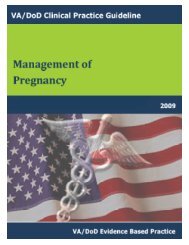DM Full Guideline (2010) - VA/DoD Clinical Practice Guidelines Home
DM Full Guideline (2010) - VA/DoD Clinical Practice Guidelines Home
DM Full Guideline (2010) - VA/DoD Clinical Practice Guidelines Home
You also want an ePaper? Increase the reach of your titles
YUMPU automatically turns print PDFs into web optimized ePapers that Google loves.
Version 4.0<br />
I<br />
II-1<br />
II-2<br />
II-3<br />
III<br />
Good<br />
Fair<br />
Poor<br />
Substantial<br />
Moderate<br />
Small<br />
Zero or<br />
Negative<br />
TABLE 1: Quality of Evidence (QE)<br />
At least one properly done RCT<br />
Well designed controlled trial without randomization<br />
Well designed cohort or case-control analytic study<br />
Multiple time series, dramatic results of uncontrolled experiment<br />
Opinion of respected authorities, case reports, and expert committees<br />
TABLE 2: Overall Quality<br />
High grade evidence (I or II-1) directly linked to health outcome<br />
High grade evidence (I or II-1) linked to intermediate outcome; or<br />
Moderate grade evidence (II-2 or II-3) directly linked to health outcome<br />
Level III evidence or no linkage of evidence to health outcome<br />
<strong>VA</strong>/<strong>DoD</strong> <strong>Clinical</strong> <strong>Practice</strong> <strong>Guideline</strong><br />
for the Management of Diabetes Mellitus<br />
TABLE 3: Net Effect of the Intervention<br />
More than a small relative impact on a frequent condition with a substantial burden of suffering;<br />
or<br />
A large impact on an infrequent condition with a significant impact on the individual patient<br />
level.<br />
A small relative impact on a frequent condition with a substantial burden of suffering; or<br />
A moderate impact on an infrequent condition with a significant impact on the individual patient<br />
level.<br />
A negligible relative impact on a frequent condition with a substantial burden of suffering; or<br />
A small impact on an infrequent condition with a significant impact on the individual patient<br />
level.<br />
Negative impact on patients; or<br />
No relative impact on either a frequent condition with a substantial burden of suffering; or<br />
An infrequent condition with a significant impact on the individual patient level.<br />
TABLE 4: Final Grade of Recommendation<br />
The net benefit of the intervention<br />
Quality of Evidence Substantial Moderate Small Zero or Negative<br />
Good A B C D<br />
Fair B B C D<br />
Poor I I I I<br />
A<br />
B<br />
C<br />
D<br />
I<br />
A strong recommendation that the intervention is always indicated and acceptable<br />
A recommendation that the intervention may be useful/effective<br />
A recommendation that the intervention may be considered<br />
A recommendation that a procedure may be considered not useful/effective, or may be harmful.<br />
Insufficient evidence to recommend for or against – the clinician will use clinical judgment<br />
Lack of Evidence – Consensus of Experts<br />
The majority of the literature supporting the science for these guidelines is referenced throughout the document and<br />
is based upon key RCTs and longitudinal studies published from 2002 through May 2009. Following the<br />
independent review of the evidence, a consensus meeting was held to discuss discrepancies in ratings and formulate<br />
recommendations. Where existing literature was ambiguous or conflicting, or where scientific data was lacking on<br />
an issue, recommendations were based on the clinical experience of the Working Group. These recommendations<br />
are indicated in the evidence tables as based on “Working Group Consensus”.<br />
Appendices Page 124
















